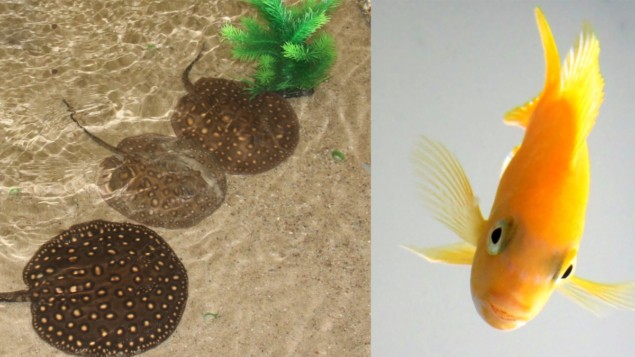Fish can add and subtract, physics of board-game box lids, a silicone raspberry for robots
01 Apr 2022 Michael Banks

It has longed been known that fish can count, at least to four, but new research shows they can apparently do much more. Researchers led by Vera Schluessel from the Institute of Zoology at the University of Bonn showed cichlids and stingrays a collection of geometric shapes such as four squares. If these objects were coloured blue, it meant “add one” while yellow meant “subtract one”. The animals were then shown two new pictures – one with five and one with three squares. If they swam to the correct picture (i.e. to the five squares in the “blue” arithmetic task), they were rewarded with food. If they gave the wrong answer, they went away empty-handed. Over time, the creatures learned to associate blue with an increase of one and yellow with a decrease of one.
To see whether they had internalized this mathematical rule, the researchers then set the fish calculations they had never seen before – and in most cases the fish gave the correct answer. “Overall, it’s a feat that requires complex thinking skills,” says Schluessel. The researchers say it is not known what the animals need this mathematical ability for or where the acquired it from. Perhaps they learned about it in their, err, schools?
Closing the lid to your favourite board game box can take a while as it slides down the base to close (sometimes also making a rude noise that can amuse any child present). This so-called “telescoping” cardboard box is commonly used to hold or ship a variety of objects from board games and footwear and mobile phones. Such boxes – where the lid barely overlaps with the base – are cheap to make and while the economic and environmental aspects have been well-studied, the physics hasn’t – until now, that is.
Many experiments
Jolet de Ruiter from Wageningen University and colleagues carried out 32 experiments on 13 commercially available boxes and 50 experiments on 11 different 3D printed models to investigate the fluid dynamics of the sliding box lid. When the lid moves over the base, its motion is largely controlled by the flow of a thin film of air in the gap. The researchers derived a theory based on low-Reynolds-number fluid flow to explain this and compared it to their experimental findings. They discovered that the fastest way for the box lid to close was not based a conventional straight lid-base configuration but for the lid to have a slight angle — just a few degrees — relative to the vertical base. If this design ever hits the shelves, then you can thank the researchers for at least thinking outside the box.
Finally, researchers at the Ecole Polytechnique Federale de Lausanne (EPFL) have created a silicone raspberry that could lead to raspberry pickers being replaced by robots. Apparently, shortages of labour are causing lots of raspberries to go unpicked, much to the chagrin of farmers and consumers alike. Robot pickers could be the solution, but raspberry picking requires great skill which has proven difficult to recreate mechanically.
That is why Josie Hughes and colleagues have created a silicone raspberry for training harvesting robots (see video). “Our sensorized raspberry, coupled with a machine learning program, can teach a robot to apply just the right amount of force,” explains PhD student Kai Junge. “The hardest part is training the robot to loosen its grip once the raspberry detaches from the receptacle so that the fruit doesn’t get squashed. That’s hard to achieve with conventional robots.” Let’s hope that the silicone raspberries don’t get mixed up with the real ones – that would make a very chewy pavlova.

Michael Banks is news editor of Physics World magazine
from physicsworld.com 4/4/2022
Δεν υπάρχουν σχόλια:
Δημοσίευση σχολίου